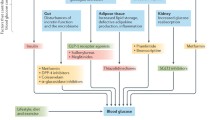Abstract
Pharmacological therapy for Type 2 (non-insulin-dependent) diabetes mellitus aims at controlling hyperglycaemia to delay or prevent complications associated with the disease. Most patients with Type 2 diabetes present with both stimulated insulin deficiency and insulin resistance. In general, the former can manifest as postprandial hyperglycaemia and the latter as fasting hyperglycaemia, though a definitive association has not been established. Emerging data show a high failure rate of long-term monotherapy and establishes the significance of mealtime glycaemia and the role of postprandial glucose excursions in the development and progression of vascular complications. To overcome such failures of monotherapy and to address the different underlying defects of the pathology of Type 2 diabetes, a combined therapy of oral antidiabetic agents with complementary modes of action should be considered. Currently used oral antidiabetic agents such as sulphonylureas, biguanides (metformin) and the thiazolidinediones (rosiglitazone, pioglitazone) commonly target fasting hyperglycaemia and have limited additive effects on postprandial glycaemia. In contrast, α-glucosidase inhibitors can reduce postprandial hyperglycaemia but gastrointestinal side effects restrict their use. The development of new agents to control postprandial glucose excursions could be considered as an additional objective for the management of Type 2 diabetes. To this end new short-acting enhancers of insulin secretion such as repaglinide (benzoic acid derivative) and nateglinide (amino acid derivative) have been developed. The combination of such agents with other complementary modes of action, e.g. an insulin sensitizer, could target better major underlying defects of Type 2 diabetes and thereby provide a better approach for controlling the entire glycaemic risk.
Article PDF
Similar content being viewed by others
Avoid common mistakes on your manuscript.
Author information
Authors and Affiliations
Additional information
Electronic Publication
Rights and permissions
About this article
Cite this article
Van Gaal, .L., De Leeuw, .I. Rationale and options for combination therapy in the treatment of Type 2 diabetes. Diabetologia 46 (Suppl 1), M44–M50 (2003). https://doi.org/10.1007/s00125-002-0936-0
Received:
Revised:
Issue Date:
DOI: https://doi.org/10.1007/s00125-002-0936-0




